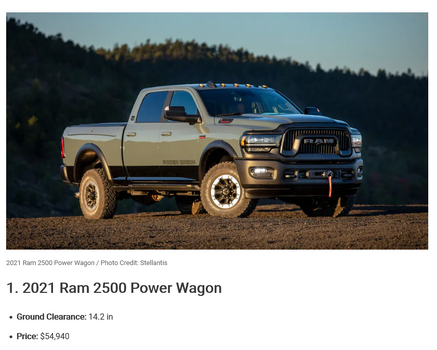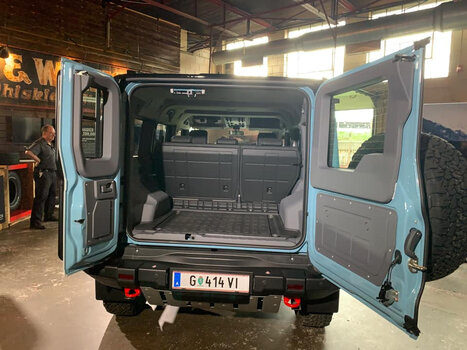- Local time
- 2:20 AM
- Joined
- Nov 14, 2021
- Messages
- 1,176
[QUOTE username=Ferrugenfish userid=9004165 postid=1332911140]
Diesel motors are a "mixed bag" over here too because of the relatively new requirement to use the DEF fluid/system, which degrades fuel economy, adds lots of weight, and is one more thing to break/fix. But apparently it saves the planet, so it's a law. I'd probably get the gas version if it had as much torque as the diesel option (and if it came with an upgraded tranny like the diesel does). We do seem to be power hogs over here in the U.S.... but that might be explained by the steep inclines, the prevelence of towing large loads, and the really high elevations (significant power loss at high elevation that we have to account for). [/QUOTE]
Hey Ferrugenfish,
You've done a great job in this thread articulating some of the differences between different national markets, and you make thoughtful critical comments of some features of the IG while simultaneously expressing support for both the vehicle's overall design, and for Ineos - for having the courage to take the risk of building a vehicle many of us never thought we'd see again as a new production-vehicle. I appreciate your approach. I think it is hard for some folk to recognize just how different markets can be, but also to recognize that the IG is a modern vehicle (despite being body-on-frame, and having solid axles). As a modern vehicle, many expect to use the IG as a "do it all" vehicle: for overlanding and on 4x4 trails, to tow a teardrop or travel trailer, but also to commute, travel on highways where traffic flows at 75 mph, and - at least in the Rockies - be able to accelerate at highway speeds at altitudes between 8,000 and 11,000 feet. In some ways, this is a tall order.
A normal day for my wife and I here in Colorado is a day like yesterday: with an early start we drove 30 minutes at 75 mph, then ascended a winding canyon, then onto a dirt road. At the end of the dirt road there was a 3-mile steep, rocky climb that a stock 4Runner handled using our rear locker and BFG KO2s. The tires are the only 'non-stock' item on the vehicle. The stock Bridgestone Duelers do not provide enough traction for these kinds of climbs, and have thin sidewalls prone to puncture. The trail would have been easier/less stressful in our old JKU on 35s. Yeah, its fun to get out, examine the line, do some spotting, but our goal was the destination more so than the actual "off-roading". The 4x4 climb got us to a trailhead at about 9,500 feet. From there, we hiked to 13,000 feet and a beautiful summit, and then made it home to start work at 12:00 noon. A great day, and we recognize how lucky we are to live like this. My point though, is to describe a typical day of vehicle use. Before we went mostly remote with work, we commuted down a canyon from 8,500 feet to 5,500 feet, and back up, and used the same vehicles for our overlanding adventures and for accessing high trailheads. I've heard some folk on this forum describe how their old Defender works great for - quote - "plodding around the country" with just 111 horse power; I think it is awesome that this works for them, but from our perspective - that is not a modern vehicle that will meet our needs. The old Defender would be great on the trails, but not on our roads. I know, because I drove a Defender in the service, and I've owned vehicles of similar design - like a 1975 FJ-40, which was built like a tank, geared super low, amazing off-road, but miserable to drive on highway. Frankly, on modern roads it was unsafe. Merging onto a highway was often dangerous without the ability to accelerate into fast-moving traffic, including 18-wheel semi trucks moving at high speed. When I look at the Grenadier, I do not compare it to the old Defender; to me that is completely irrelevant. Instead, I try to assess how well it will meet our present needs.
Anyway... I also wanted to mention that since 2018, the BMW B58 has been equipped with a Petrol Particulate Filter (PPF), also called a Gasoline Particulate Filter (GPF), to capture soot that is produced as a consequence of direct injection. This allows the B58 to meet Euro-6 emissions. I do not know for sure that the Grenadier will come with a GPF, but from what I have been able to learn, BMW is no longer producing the B58 without a GPF. Someone please correct me if I am wrong. GPFs do not seem to be as problematic as the diesel emission systems (EGR and the use of Diesel Exhaust Fluid), but the gas option also has some 'new' emissions controls.
We are looking forward to test-driving the Grenadier!
Diesel motors are a "mixed bag" over here too because of the relatively new requirement to use the DEF fluid/system, which degrades fuel economy, adds lots of weight, and is one more thing to break/fix. But apparently it saves the planet, so it's a law. I'd probably get the gas version if it had as much torque as the diesel option (and if it came with an upgraded tranny like the diesel does). We do seem to be power hogs over here in the U.S.... but that might be explained by the steep inclines, the prevelence of towing large loads, and the really high elevations (significant power loss at high elevation that we have to account for). [/QUOTE]
Hey Ferrugenfish,
You've done a great job in this thread articulating some of the differences between different national markets, and you make thoughtful critical comments of some features of the IG while simultaneously expressing support for both the vehicle's overall design, and for Ineos - for having the courage to take the risk of building a vehicle many of us never thought we'd see again as a new production-vehicle. I appreciate your approach. I think it is hard for some folk to recognize just how different markets can be, but also to recognize that the IG is a modern vehicle (despite being body-on-frame, and having solid axles). As a modern vehicle, many expect to use the IG as a "do it all" vehicle: for overlanding and on 4x4 trails, to tow a teardrop or travel trailer, but also to commute, travel on highways where traffic flows at 75 mph, and - at least in the Rockies - be able to accelerate at highway speeds at altitudes between 8,000 and 11,000 feet. In some ways, this is a tall order.
A normal day for my wife and I here in Colorado is a day like yesterday: with an early start we drove 30 minutes at 75 mph, then ascended a winding canyon, then onto a dirt road. At the end of the dirt road there was a 3-mile steep, rocky climb that a stock 4Runner handled using our rear locker and BFG KO2s. The tires are the only 'non-stock' item on the vehicle. The stock Bridgestone Duelers do not provide enough traction for these kinds of climbs, and have thin sidewalls prone to puncture. The trail would have been easier/less stressful in our old JKU on 35s. Yeah, its fun to get out, examine the line, do some spotting, but our goal was the destination more so than the actual "off-roading". The 4x4 climb got us to a trailhead at about 9,500 feet. From there, we hiked to 13,000 feet and a beautiful summit, and then made it home to start work at 12:00 noon. A great day, and we recognize how lucky we are to live like this. My point though, is to describe a typical day of vehicle use. Before we went mostly remote with work, we commuted down a canyon from 8,500 feet to 5,500 feet, and back up, and used the same vehicles for our overlanding adventures and for accessing high trailheads. I've heard some folk on this forum describe how their old Defender works great for - quote - "plodding around the country" with just 111 horse power; I think it is awesome that this works for them, but from our perspective - that is not a modern vehicle that will meet our needs. The old Defender would be great on the trails, but not on our roads. I know, because I drove a Defender in the service, and I've owned vehicles of similar design - like a 1975 FJ-40, which was built like a tank, geared super low, amazing off-road, but miserable to drive on highway. Frankly, on modern roads it was unsafe. Merging onto a highway was often dangerous without the ability to accelerate into fast-moving traffic, including 18-wheel semi trucks moving at high speed. When I look at the Grenadier, I do not compare it to the old Defender; to me that is completely irrelevant. Instead, I try to assess how well it will meet our present needs.
Anyway... I also wanted to mention that since 2018, the BMW B58 has been equipped with a Petrol Particulate Filter (PPF), also called a Gasoline Particulate Filter (GPF), to capture soot that is produced as a consequence of direct injection. This allows the B58 to meet Euro-6 emissions. I do not know for sure that the Grenadier will come with a GPF, but from what I have been able to learn, BMW is no longer producing the B58 without a GPF. Someone please correct me if I am wrong. GPFs do not seem to be as problematic as the diesel emission systems (EGR and the use of Diesel Exhaust Fluid), but the gas option also has some 'new' emissions controls.
We are looking forward to test-driving the Grenadier!












